What is Healthcare Employee Satisfaction Survey? A Definitive Guide

Unhappy employees lead to unhappy patients. A healthcare employee satisfaction survey is your secret weapon. It reveals the pulse of your workforce. It’s more than a questionnaire; it’s a roadmap. Improve patient care, boost retention, and elevate your healthcare facility.
This guide dives into the Hospital Employee Satisfaction Survey. We explore measuring morale and create a survey with perfect questions. Get ready to transform your workplace from the inside out.
A study by SurveyMonkey Says that great patient care starts with engaged employees. The study found that most healthcare organizations get this connection. They measure employee satisfaction as a result. Are you? Comment down!
What is Healthcare Employee Satisfaction Survey?
This survey means your staff is dedicated and passionate about their work. It’s not just about showing up for work, it’s about caring about the work you do. Engaged healthcare workers feel connected to their organization. They are proud of their roles. They are motivated to go the extra mile for patients.
Think of it this way: A highly engaged healthcare team is like a well-oiled machine. Everyone knows their job, works together smoothly, and delivers top-notch care. On the other hand, a disengaged team is like a car with a flat tire. It’s slow, inefficient, and likely to break down.
The hospital Employee Satisfaction Survey is crucial because:
- Improved patient outcomes: Engaged staff provide better care.
- Higher job satisfaction: Happy employees stay longer.
- Increased productivity: Engaged teams work smarter, not harder.
- Stronger employer brand: A great place to work attracts top talent.
- Lower turnover costs: Replacing staff is expensive and time-consuming.
Suggested Read:
What are the Different Levels of Hospital Employee Satisfaction?
Staff satisfaction in hospitals comes at different levels. These levels show how much people care about their jobs and the hospital. People feel different levels of commitment, motivation, and connection to their work. There’s no exact way to measure these levels, but they usually include:
1. Disengaged:
- These employees are checked out. They come to work, but their hearts aren’t in it. They’re often unhappy, unproductive, and looking for a way out. Disengaged employees can have a negative impact on morale and patient care.
2. Unhappy but Engaged:
- These employees are committed to their jobs, but they’re not happy. They might be overworked, underpaid, or dealing with a toxic work environment. While they show up and do their jobs, they’re not going above and beyond.
3. Satisfied and Engaged:
- These employees are happy with their jobs and committed to the organization. They’re productive, positive, and contribute to a positive work environment. Satisfied and engaged employees are the backbone of many successful healthcare teams.
4. Highly Engaged:
- These employees love their jobs. They feel a strong bond with the organization. They’re enthusiastic, innovative, and go above and beyond to achieve goals. Highly engaged employees are invaluable assets to any healthcare facility.
5. Advocates:
- These employees are not just engaged; they’re passionate champions for the organization. They promote the company, recruit new talent, and build strong relationships with patients. Advocates are the ultimate goal of any healthcare organization.
Suggested Read:
Why Hospital Employee Satisfaction Survey is Important?
Employee satisfaction is crucial for hospitals. Happy workers mean better care. Low satisfaction can cause mistakes and lawsuits. This can cost the hospital money and harm patient care.
Doctors, nurses, and other medical staff need to be very engaged. They take care of patients directly. Office workers also play a key role in patient records, insurance, and privacy. Even cleaning staff helps keep patients safe. Everyone matters.
Hospitals need staff 24/7. If people are often absent or quit, patients are less happy. This can hurt the hospital’s reputation and profits, making it harder to buy new equipment.
How to Measure Employee Satisfaction in Healthcare?
We measure staff satisfaction in healthcare by using different tools. We ask employees and managers about their work experiences. We also want to know their opinions and how happy they are.
Measuring employee satisfaction in healthcare is important. It helps improve patient care and makes the organization more successful. Here are some key methods:
Employee Satisfaction Survey
- Surveys are a cornerstone of measuring employee satisfaction. They can be conducted online, in person, or through paper-based questionnaires. Effective surveys look at several areas. They cover job satisfaction, work environment, leadership, compensation, and growth opportunities.
Employee Net Promoter Score (eNPS)
- eNPS is a simple yet powerful metric to gauge employee loyalty. It asks employees how likely they are to recommend your organization as a workplace. Strong employee advocacy correlates with a high eNPS.
Exit Interviews
- Exit interviews aren’t a strict measurement tool. However, they offer valuable insights into why employees leave. Understanding reasons for departure helps identify areas for improvement in employee satisfaction.
Pulse Surveys
- Pulse surveys are short, frequent surveys that check in on employee sentiment. They help track changes in employee satisfaction over time and identify emerging issues.
Employee Suggestion Boxes
- Encourage employees to share their ideas and feedback through suggestion boxes. This anonymous channel can reveal valuable insights. It also shows employees that their voices are heard.
People Analytics
- Leverage data analytics to analyze employee performance, turnover rates, absenteeism, and other metrics. These data points can help identify trends and correlations related to employee satisfaction.
Focus Groups and One-on-One Interviews
- In-depth conversations with employees can provide rich qualitative data. Focus groups and one-on-one interviews help explore employee experiences more deeply. They also uncover concerns more clearly.
Suggested Read:
How to Create a Healthcare Employee Satisfaction Survey?
An effective survey helps you understand your staff’s needs. It also improves your workplace. Below is a step-by-step guide on how to create a survey:
1. Define Your Goals
- Identify what you want to learn: Clearly outline the purpose of your survey. Are you measuring overall satisfaction, specific departments, or addressing particular issues?
- Set clear objectives: Knowing your goals helps you make focused questions. This way, you can get the answers you need.
2. Keep it Relevant and Concise
- Focus on key areas: Discuss key topics such as job satisfaction, work environment, leadership, pay, and career growth.
- Avoid overly long surveys: People are busy. Keep it short and sweet.
3. Choose the Right Question Types
- Mix it up: Use both closed-ended and open-ended questions. Closed-ended questions include multiple choice and rating scales. Detailed responses arise from open questions.
- Use clear and simple language: Avoid jargon or complex wording.
4. Ensure Anonymity and Confidentiality
- Build trust: Assure employees that their responses are confidential and anonymous.
- Create a safe space: Encourage honest feedback. Make it clear that there are no consequences for sharing opinions.
5. Pilot Test Survey
- Get feedback: Test a small group of employees to identify any issues.
- Make adjustments: Refine questions or formatting based on feedback.
6. Choose the Right Distribution Method
- Consider your audience: Find the best way to reach your employees. You can use email, online methods, or paper.
- Offer multiple options: Offer different ways to complete. This will fit different preferences.
7. Analyze and Act on Results
- Use data effectively: Analyze results to identify trends and problem areas.
- Create an action plan: Develop strategies to address employee concerns and improve satisfaction.
- Communicate results: Share key findings with employees to show you’re listening.
8. Follow Up
- Close the loop: Demonstrate that you’ve taken action on employee feedback.
- Measure progress: Track employee satisfaction over time. This will help you see if improvements have been made.
Top 5 Benefits of Hospital Employee Satisfaction Survey
Employee pulse survey offers many benefits. They help improve staff well-being. This, in turn, contributes to the organization’s success. When employees are more satisfied, patient satisfaction also improves. It provides many benefits. Here are the top five:
1. Improved Patient Care
- Happy and engaged employees provide better patient care. When staff feel valued and supported, they’re more likely to go the extra mile for patients. It helps you identify areas where you can improve patient experiences.
2. Increased Employee Retention
- Losing employees is costly and time-consuming. Find out what makes your staff happy and what frustrates them. Then, take steps to improve retention. High employee satisfaction leads to lower turnover rates.
3. Boosted Employee Morale
- Showing employees that their opinions matter can significantly boost morale. Surveys show that you care about their well-being. They also show you are dedicated to creating a positive work environment.
4. Enhanced Workplace Culture
- A strong workplace culture is built on trust and open communication. Surveys provide a platform for employees to share their thoughts and ideas. This Promotes teamwork and creativity.
5. Improved Organizational Performance
- Happy and engaged employees are more productive. When your staff feels valued and supported, they’re more likely to go above and beyond. Increased productivity leads to better organizational performance and financial success. Conducting an employee pulse survey is an investment in your healthcare organization’s future. Listen to your employees. This helps build a successful workplace. Everyone benefits from it.
What are 20 Healthcare Employee Satisfaction Survey Questions?
Creating good questions is key to successful employee satisfaction. It helps get the right answers. Here are 20 questions to measure healthcare staff satisfaction. They cover different aspects of the work environment and employee experience. These questions help understand how satisfied healthcare professionals are and find areas that need improvement:
Overall Job Satisfaction
- How satisfied are you with your overall job at [Hospital Name]?
- Do you feel challenged and fulfilled in your role?
- Do you believe your job contributes to the overall success of the hospital?
Work Environment
- How would you rate the work environment at your department?
- Do you feel supported by your colleagues?
- How satisfied are you with the communication within your department?
- Do you feel valued as an employee?
Leadership and Management
- How effective is your immediate supervisor in providing guidance and support?
- Do you feel your opinions and suggestions are valued by management?
- Do you believe there are opportunities for career growth within the organization?
Work-Life Balance
- Do you feel you have a good work-life balance?
- Is the workload manageable?
- Does the hospital offer adequate support for work-life balance initiatives?
Compensation and Benefits
- Are you satisfied with your overall compensation package?
- Do you feel your benefits package meets your needs?
Professional Development
- Does the hospital provide opportunities for professional development?
- Do you feel your skills are being utilized to their full potential?
Patient Care
- How satisfied are you with the quality of patient care provided at the hospital?
- Do you feel you have the necessary resources to provide optimal patient care?
Open-Ended Question
- Is there anything else you would like to share about your experience at [Hospital Name]?
Top 5 Healthcare Employee Satisfaction Survey Tools
Healthcare is a tough industry. Keeping your staff happy is key to good patient care. They show what’s working and what isn’t.
With so many tools available, picking the right one can be hard. That’s why we’ve made a list of the top 5 hospital staff survey tools.
SurveySlack
SurveySlack is a powerful and easy-to-use tool for healthcare organizations. It helps you create, distribute, and analyze employee satisfaction surveys. SurveySlack has a simple interface and strong features. It makes getting valuable feedback from your staff easy. This helps drive positive change. SuveySlack also has a tool called AI Survey Questions Generator.
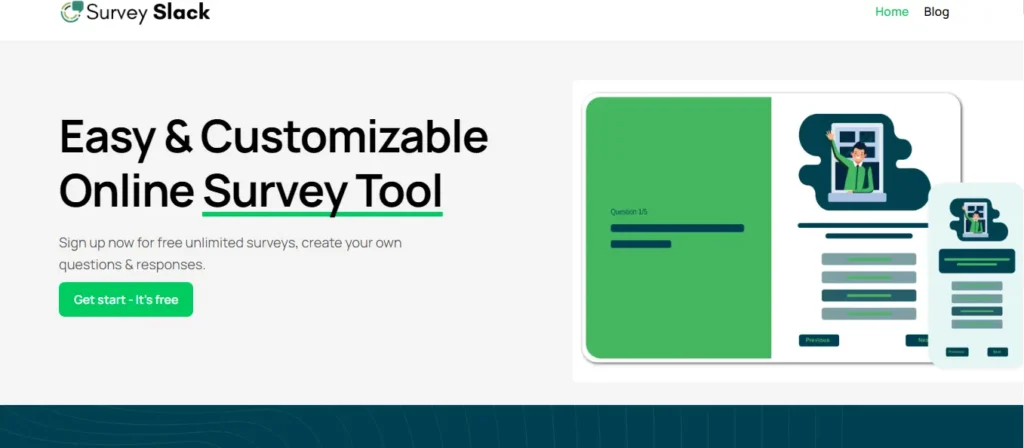
Key Features
- Drag-and-drop builder: Create professional surveys without coding.
- Customizable question types: Pick the question format that works best for you. You have several options.
- Logic jumps: Create dynamic surveys based on respondent answers.
- Real-time reporting: Track progress and results in real-time.
- Advanced analytics: Dive deep into data with comprehensive reports.
- Integration with popular tools: Connect with Slack, Microsoft Teams, and more.
- Mobile-friendly: Access surveys and results on any device.
- Automated reminders: Increase response rates with automated reminders.
- Data export: Export data to Excel or CSV for further analysis.
- Compliance features: Ensure data privacy and security.
Pros
- Easy to use: Intuitive interface for users of all skill levels.
- Cost-effective: Affordable pricing plans for businesses of all sizes.
- Time-saving: Automate many tasks, freeing up your time.
- Flexible: Customize to fit your specific needs.
- Comprehensive: Offers a wide range of features and functionalities.
- Reliable: Strong track record of performance and uptime.
- Secure: Protects sensitive employee data.
- Excellent customer support: Helpful and responsive support team.
- Integrations: Works seamlessly with other tools you use.
- Mobile-friendly: Access surveys and results on the go.
Cons
- Limitations: Basic and advanced features are available in the free plan.
Cost
- Freemium.
Jotform
Jotform is an online form builder perfect for crafting healthcare surveys. It’s easy to use and offers a wide range of features to create engaging questionnaires.
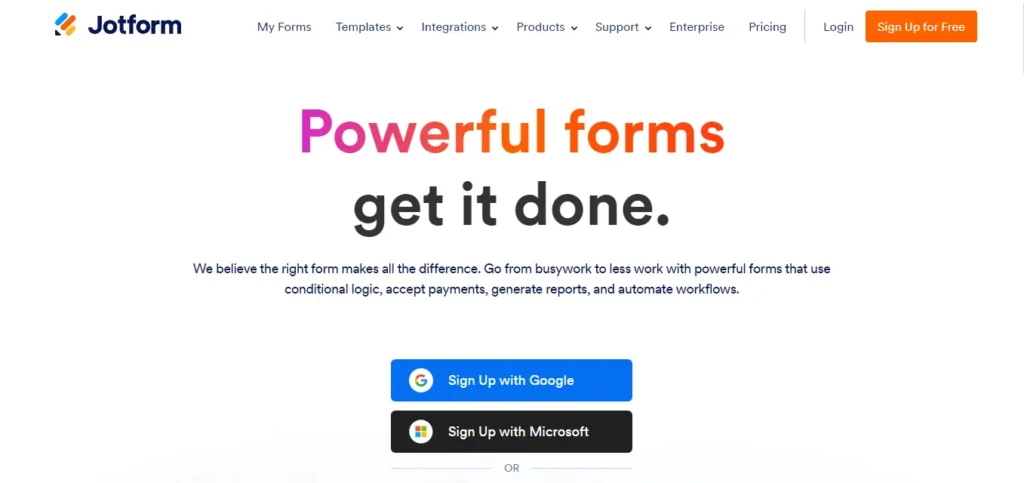
Key Features
- Drag-and-drop builder: Create without coding.
- Question variety: Offer different question types to gather diverse feedback.
- Conditional logic: Tailor questions based on previous answers.
- Integrations: Connect with popular tools for data management.
- Mobile-friendly: Ensure easy access for all employees.
Pros
- User-friendly: Simple interface for quick creation.
- Cost-effective: Offers free and affordable plans.
- Customization: Tailor surveys to match your organization’s style.
- Data analysis: Basic reporting tools to understand results.
- Wide range of templates: Get started quickly with pre-built surveys.
Cons
- Limited advanced analytics: For complex data analysis, consider other tools.
- Steeper learning for complex forms: Advanced features might require more time to master.
Cost
- Free plan with Basic Features.
Typeform
Typeform is an online form builder perfect for crafting healthcare surveys. It’s easy to use and offers a wide range of features to create engaging questionnaires.
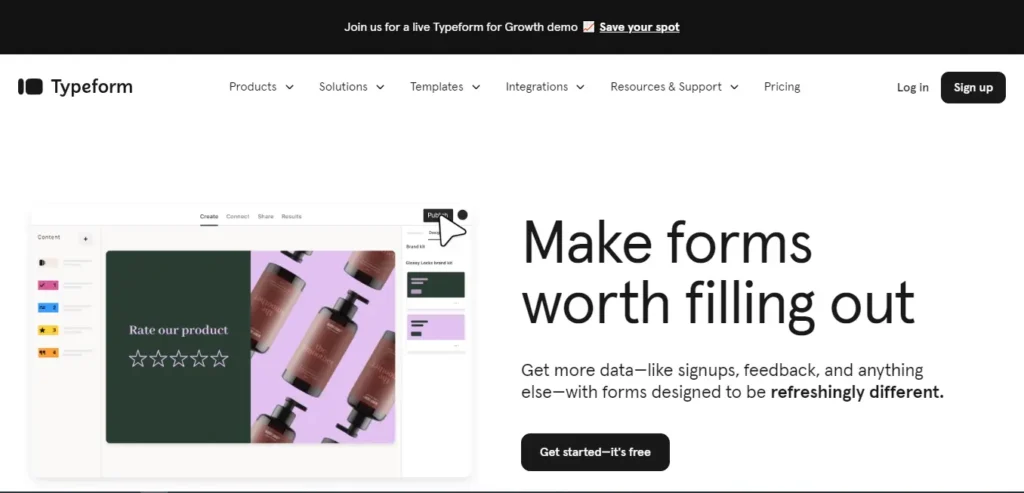
Key Features
- Drag-and-drop builder: Create without coding.
- Question variety: Offer different question types to gather diverse feedback.
- Conditional logic: Tailor questions based on previous answers.
- Integrations: Connect with popular tools for data management.
- Mobile-friendly: Ensure easy access for all employees.
Pros
- User-friendly: Simple interface for quick creation.
- Cost-effective: Offers free and affordable plans.
- Customization: Tailor surveys to match your organization’s style.
- Data analysis: Basic reporting tools to understand results.
- Wide range of templates: Get started quickly with pre-built surveys.
Cons
- Limited advanced analytics: For complex data analysis, consider other tools.
- Steeper learning for complex forms: Advanced features might require more time to master.
Cost
- Free Plan with Limited Features.
SurveyMonkey
SurveyMonkey is a popular tool for making surveys. It can be used for many purposes, including employee satisfaction. It has a user-friendly interface and many features. This makes it a top choice for healthcare organizations.
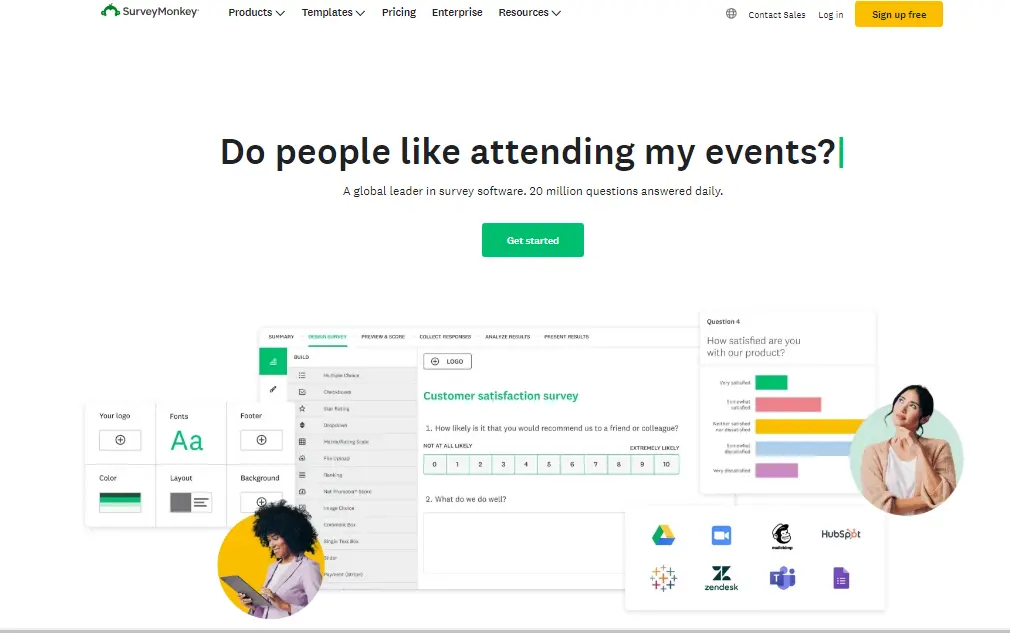
Key Features
- Drag-and-drop builder: Easily create professional surveys.
- Question library: Access pre-written questions to save time.
- Logic jumps: Customize flow based on answers.
- Data analysis: Generate reports and charts to understand results.
- Integrations: Connect with other tools for seamless workflow.
Pros
- User-friendly: Easy to learn and use for beginners.
- Wide range of features: Suitable for various needs.
- Data security: Protects employee information.
- Cost-effective: Offers plans to fit different budgets.
- Large user base: Strong reputation and support.
Cons
- Can feel basic: Compared to newer platforms, the interface might seem outdated.
- Pricing tiers: Can be confusing to choose the right plan.
Cost
- Free Plan with Limited Features.
Zoho
Zoho Survey is a comprehensive platform that offers more than just creation. It’s part of the Zoho suite, integrating seamlessly with other tools. This makes it a strong contender for healthcare surveys.
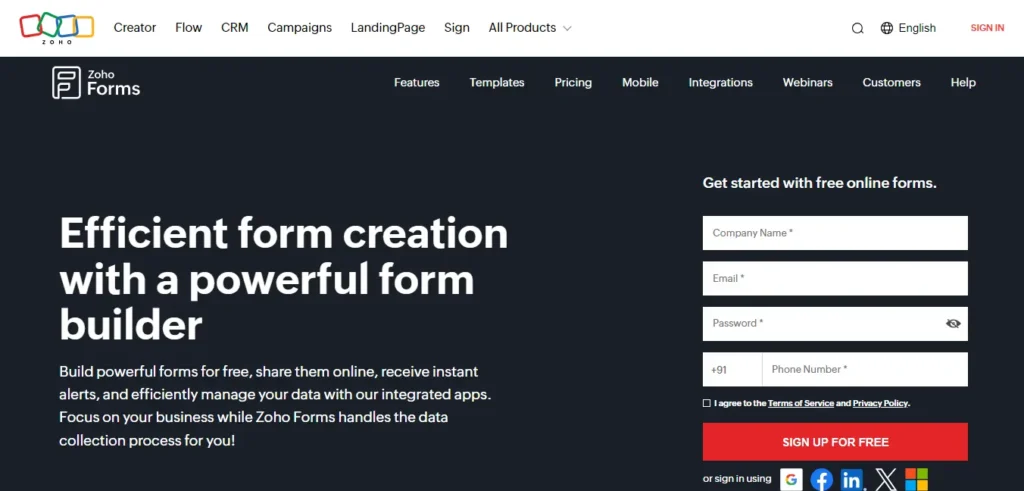
Key Features
- Drag-and-drop builder: Create surveys easily.
- Question logic: Customize flow based on answers.
- Multiple question types: Choose from various options.
- Real-time reporting: Track progress and results.
- Integrations: Connect with other Zoho apps and third-party tools.
Pros
- Affordable pricing: Offers competitive plans.
- Part of Zoho ecosystem: Integrates with other business tools.
- Customization options: Tailor surveys to your needs.
- Mobile-friendly: Access it on any device.
- Strong customer support: Assistance when needed.
Cons
- Learning curve: Might take time to master advanced features.
- Complexity: The interface might feel overwhelming for simple surveys.
Cost
- Free Plan with Limited Features.
The Wrap-Up
Employee satisfaction is crucial in healthcare. Happy and engaged staff lead to better patient care and higher retention rates. They also help build a stronger reputation. Healthcare facilities can get better by using employee satisfaction surveys.
They should act on the feedback they receive. This helps create a positive work environment. This helps improve overall performance and patient care.





